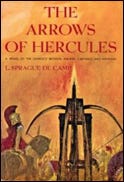The Arrows of Hercules takes place in the early years of the reign of Dionysius of Sicily. Its hero, Zopyras, is an engineer who invents the first useful artillery of the ancient world, the arrow-throwing machine the Romans would adopt and use for centuries, calling it a ballista. The adventures of Zopyras include a battle against Etruscan pirates, a kidnapping in Carthage, and a taste of a slave auction from the viewpoint of the merchandise. In the process, he makes friends across international borders. The novel's historical merit flows mostly from the glimpses it offers of the different cultures that jostled elbows in the middle of the Mediterranean, with a good survey of the assortment of varied beliefs then prevalent, including an accurate depiction of the era’s more matter-of-fact acceptance of nudity.
Much of the fun in The Arrows of Hercules comes from watching an ancient engineer face the incompetent supervisors and production setbacks that figure in the average Dilbert cartoon. Instead of a modern cubicle, the struggle against departmental rivals and bureaucratic snafus takes place in the Tyrant of Syracuse’s fortress-complex of Ortygia. De Camp’s cheerful narrative voice will be familiar to anyone raised on the great post-war generation of science fiction writers; the author was one of them and dedicates his novel, “To Isaac Asimov and Bob Heinlein in memory of our own Ortygian days.” (1965, 297 pages)






L. Sprague de Camp wrote a non-fiction book called "The Ancient Engineers" which I remember reading a long time ago. I expect this piece (which I wasn't at all familiar with) was an outgrowth of that book, though it could easily be the other way around.
Thanks!